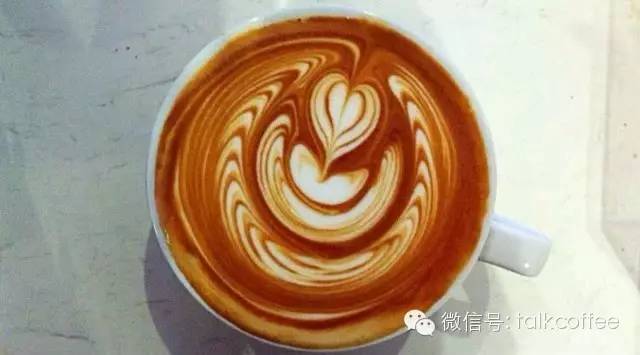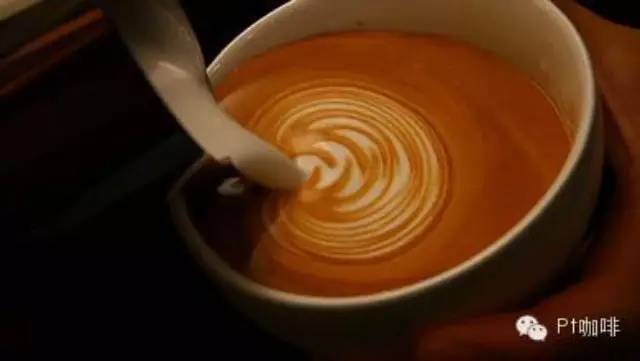A course in making Italian Coffee: a detailed explanation of the principles of hydrodynamics in Coffee pattern

Friends who have seen the coffee flower will probably be amazed by the skill of the barista. The hot white milk rushed into the dark brown espresso, and as the barista's wrist lightened, the surface of the latte rippled with a heart-like leaf pattern. It's so romantic, so romantic.
There are two main types of coffee latte art:
One is free pour, which "pulls" patterns while pouring hot milk into espresso (espresso).
The other is etching, in which milk and coffee are mixed and carved directly on the foam on the surface of the latte with accessories such as chocolate sauce and toothpicks at the top.
Compared with carving, the former is more wonderful, while the latter is more versatile. This is because when carving, the foam on the surface of the latte is stable and can support colored sauces such as chocolate sauce and caramel syrup, not only giving baristas more time, but also more freedom in drawing and composition. The wonder of the flower is that the pattern is formed in the process of preparing the latte.
The secret of pulling flowers, experienced baristas may start with how to make espresso and hot milk foam. However, physically speaking, what is coffee flower pulling all about?
Well, we have to start with the surface agent.
Surfactants, or surfactants, are a very wide range of substances that can be found everywhere in daily life. Washing powder and dishwashing liquid rely on it to remove oil and dirt, and children rely on it to blow bubbles. Without it, many drinks, including milk, would not be what we see. When used in the food industry, surfactants are sometimes called emulsifiers.
Surface agents are generally small organic molecules with both hydrophilic and hydrophobic parts. A typical surface agent has the following structure: a hydrophilic polar group head (the ball in B) and one or more long tails, which are hydrophobic groups (usually longer carbon chains) that like to dissolve in non-polar media such as oil. Many readers have learned in high school that the phospholipid molecules that make up the cell membrane of an organism also have this structure. it has two hydrophobic tails and can also be used as a surfactant. It is worth noting that the image of this surfactant should not be confused with what we often call "tadpoles".

If we add some surfactants to the water, then because the hydrophobic tail does not like to be close to the water, if the tail is close to the tail, and the hydrophilic head is used to separate the water from the tail, then the energy of the whole system will be lower. As shown in the following illustration, this can form a variety of structures: a small spherical micelle (Micelle) with a hydrophilic head wrapped in a hydrophobic tail or a capsule shape, or a spherical shape wrapped by two layers of surfactant molecules (Liposome in the image below), or a planar film formed by double-layer molecules. This system is believed to be related to the initial formation of life, that is, how primordial cells are formed from primordial soups mixed with a variety of organic molecules, including primitive RNA or DNA.

One of the important properties of surface agents is that they can mix two liquids or a liquid and a solid powder that cannot be mixed to form an emulsion or colloid. For example, water and oil can form an emulsion by adding some surface agents. According to the different ratio of water to oil, the formed structure can be oil-in-water, water-in-water, or oil-water layered multi-layer structure, and the surface agent is on the interface between water and oil, which ensures the stability of the system. An important application of this feature is to wash away grease from clothes.

Proteins generally have both hydrophilic and hydrophobic groups, so many proteins can act as surface agents. The mayonnaise in western food is a sauce made mainly of vegetable oil, eggs, lemon juice or vinegar and other seasonings, in which the protein in the egg acts as a surface agent, mixing vegetable oil and water. Milk is a natural milky liquid, and the protein it contains will also wrap the fat in the milk and suspend it in the water. If the system is destroyed by external forces, fat can be collected to get butter and protein to get cheese.
The surface agent can also be used to stabilize the interface between air and water, to put it simply, to blow bubbles. When many small bubbles gather together, and the water between them goes away, they will come into contact with each other to form a polyhedral structure: foam. At this time, the hydrophobic tail is exposed to the air, and the hydrophilic head is stuck in a thin layer of water, and the presence of the surfactant reduces the surface tension of the air and water, allowing the structure of this foam to exist for a period of time. Let children enjoy the fun of blowing bubbles, let photographers take pictures of them, let scientists study their properties, and allow baristas to make coffee flowers.

The cup that makes coffee flower should first put espresso (Espresso) with a volume of about 1/3. This is a kind of coffee with a strong taste, which can be obtained by washing the coffee powder under high pressure with near-boiling hot water. On the surface of espresso is a layer of reddish-brown foamy coffee fat (crema). This layer of coffee fat is the foam formed by the fat and gas in the coffee, while the surface agent is the protein in the coffee and phospholipid molecules in the cell membrane.

The volume of coffee fat generally accounts for more than 10% of espresso, and the volume content of gas can account for about half of coffee fat. Looking at the structure of coffee fat under an optical microscope, it can be seen that it contains bubbles, fat particles (usually less than 10 microns) and some solid particles (fragments of the cell wall of coffee beans) [5]. Do not underestimate this layer of coffee fat, the existence of coffee fat is often used as a sign of the quality of espresso, not only that, coffee fat itself is also an important factor in the formation of coffee flowers.

Coffee fat observed under an optical microscope. ]
In the process of making coffee flowers, the hot milk poured into espresso is pre-treated. With the protein in milk as the surface agent, and by means of stirring, the surface of hot milk forms a layer of foam (microfoam) mixed with milk and air.
In the process of mixing hot milk and espresso, two kinds of foam are mixed: one is a mixture of air and milk, and the other is a mixture of fat, gas and espresso fat on the surface of espresso. These two kinds of foam are relatively stable, the foam of coffee fat can generally last about 10 minutes [5], and the foam formed by milk and air can also last for several minutes [8].
After these two kinds of foams are mixed together, because their particles are large (micron level) and squeezed together, the diffusion process of the particles is very slow, without stirring, the mixing rate between the two kinds of foam will be very slow, therefore, the boundary between bubbles will remain clear for a long time. In this way, the pattern made when the barista pours the milk can be kept for long enough for customers to appreciate.

Some readers may ask, why do bubbles have to be mixed together, but not liquids of different colors?
When we pour milk into coffee, although there are still micron-sized particles in the two liquids, these particles are not close to each other, and these particles account for only a small part of the liquid. Even if they do not mix evenly with each other immediately, because the flow of the internal liquid is very unstable, the interface between the two liquids will soon become blurred by diffusion. It can't be made into a pattern of drawing flowers.
In fact, in addition to coffee flower, the surface agent has a very important application in our daily life and industrial production. In the process of washing clothes and dishes, the hydrophobic tail of the surface agent goes deep into the stain, and the hydrophilic head is closely connected with the water. Under the movement of washing, the stain is wrapped into suspended particles and goes with the water. In the food industry, topical agents are used to mix different ingredients to obtain new tastes and traits (such as mayonnaise mentioned earlier). In industrial production, surface agents can be used to mix different raw materials to facilitate chemical reactions, or to mix different materials to facilitate subsequent processing (such as paint).
Source: mikocoffee
Important Notice :
前街咖啡 FrontStreet Coffee has moved to new addredd:
FrontStreet Coffee Address: 315,Donghua East Road,GuangZhou
Tel:020 38364473
- Prev

The course of making Italian Coffee: the influence of the Fusion of Milk foam and Milk on flower drawing
What is the fusion degree of milk foam and milk? The fusion degree of milk foam and milk refers to the degree of combination of milk foam and milk after getting rid of milk foam. How to judge the fusion degree of milk foam and milk? Principle: just sent milk foam, milk foam and milk are mixed together, need to rest for a period of time, milk foam and milk will be separated to form layers, and the length of time
- Next

A course on making Italian Coffee; A detailed introduction to the making skills of Milk foam in Coffee pattern Technology
What is the fusion degree of milk foam and milk? The degree of fusion of foam and milk refers to the degree to which the foam combines with milk after getting rid of the foam. How to judge the fusion degree of milk foam and milk? Principle: just sent milk foam, milk foam and milk are mixed together, need to rest for a period of time, milk foam and milk will be separated to form layers, and the length of time
Related
- What is the meaning of lactic acid fermentation with coffee bean treatment?
- How to judge the state of foam by sound?
- How does the latte pull out the unicorn pattern? Come to get for a little trick to improve the flower pull!
- Will flower pulling affect the taste of the latte?
- Do you know the history of coffee?
- The difference between honey treatment and sun washing what is raisin honey treatment?
- What kind of milk can a novice use to make coffee foam to keep the foam longer? The correct method and skills of milking tutorial sharing
- Why do washed coffee beans taste sour? Flavor characteristics of washed Coffee
- Introduction to the skill of how to practice the size and height of water injection around the circle of hand-brewed coffee
- How do beginners practice coffee flower drawing from scratch?

